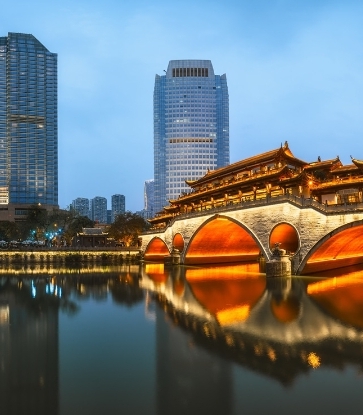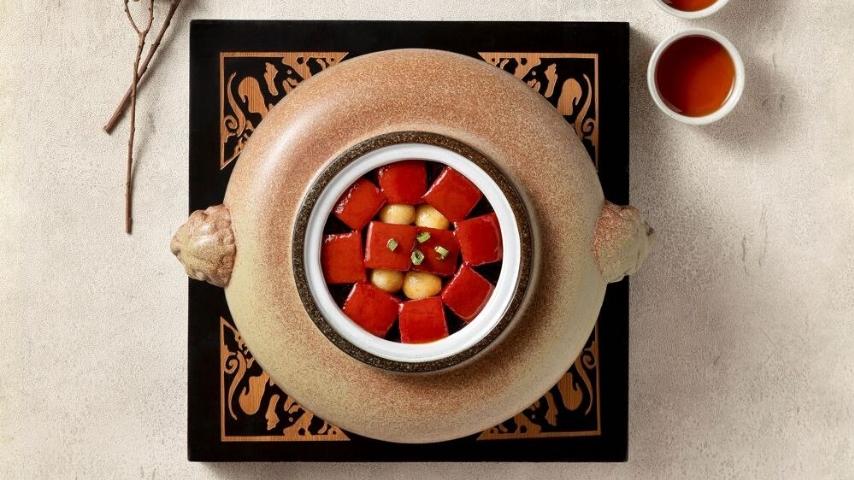“A traditional dish from Sichuan province, it has a rich mala flavour and is smooth and tender.” – Chinese Recipes: Sichuan (published in 1972)
Modern Sichuan cuisine is known for its spicy, pungent flavours. Think iconic dishes such as the appetiser of sliced beef and beef offal in chilli oil, and the famed main dish of water-boiled fish. Yet, only the above brief description of water-boiled beef can be found in recipe books written over half a century ago, with absolutely no mention of water-boiled fish.
“Yes, water-boiled fish is indeed a modern interpretation of water-boiled beef. After all, when a dish becomes famous, you’ll start seeing variations of it popping up, just like Kung Pao Chicken and Kung Pao Prawns, or Yu Xiang Eggplant (braised eggplant with shredded pork) and Yu Xiang Chicken,” explains Deng Huadong, celebrated Chinese chef and CEO of Sichuan restaurant Deng G (Wan Chai) in Hong Kong. Deng is the protégé of renowned chef Chen Tingxin, whose mentor was Kong Daosheng, a disciple of Master Lan Guangjian – a prominent figure of modern Sichuan cuisine.


Of course, the world of Sichuan cuisine is boundless and everyone has a different approach. Taking Chongqing restaurants that serve Jianghu cuisine as an example, “bean sprouts are placed inside the bowl; the fish is poached in the soup and then placed over the bed of bean sprouts together with the chillies before boiling oil is poured over all the ingredients,” says chef Deng.
When it comes to what makes water-boiled fish so tasty, chef Deng says the key is to sprinkle stir-fried and chopped red Sichuan peppercorns and dried chillies over the fish slices then pour hot oil over them. “This technique gives the dish an exquisite aroma and unique numbing spicy (mala) flavour.” The star ingredient of fish or meat must also be velveted and then placed into the pot piece by piece to ensure its tenderness. Then it’s all about the control of heat.
The water-boiled fish, water-boiled eel and even water-boiled chicken that we see in restaurants nowadays are all reimagined versions of the original water-boiled beef. This gives us a glimpse of Sichuan cuisine’s appeal and popularity.


Chef Deng believes that water-boiled beef originated in Zigong, a city in Sichuan known as “the City of Salt”. “Salt produced in Zigong was a tribute offered to the imperial court. There were no machines back then, and the salt wells were very deep, so the bitterns were pulled up from the wells by oxen and made into salt.” But cows had always been a loved and respected farming animal in ancient China, so why did farmers eat beef? “In the past, cows were very precious and cannot be slaughtered or consumed until their retirement,” he says. At the beginning, farmers would casually set up a pot roadside, placing thinly sliced beef, water and a touch of seasoning into the pot and eating around the fire for a home-cooked dish that was great for replenishing strength and energy. Later on, this dish began appearing at restaurants. Chefs would elevate the dish by velveting the meat after cutting it into slices, and adding lots of other ingredients such as salt, broad bean paste, celtuce, celery, garlic sprouts and Chinese cabbage. The dish has since become more flavourful and elevated, but now resembles nothing of the “water-boiled” original. “I suppose it depends on how you perceive it!” Chef Deng laughs.

Some chefs who specialise in Cantonese cuisine have also tried to create a new and improved version of this famous dish. Nansen Lai is the owner of the MICHELIN-selected Sichuan restaurant Jing Alley
Nansen explains his concept for the Chengdu-style water-boiled fish: soup comes first, oil second, with a ratio of 9:1. He admits that authenticity wasn’t on his mind when he created the dish, but it must taste good. He creates the oil blend himself, using ingredients like green and red Sichuan peppercorn oil; he chooses to use milder chillies, such as the Chinese green peppers, Yunnan green wrinkly peppers, dried green chillies from North Korea, and Thai green chillies. The soup base is made with pork bone. “I want my customers to be able to drink all the soup.”
RELATED: Kung Wo Beancurd Factory: Soy Products to Take You Down Memory Lane




In place of the commonly used Chinese perch, Nansen offers his customers the choice of the more premium Chinese northern snakehead, UK ocean perch or Japanese hand-caught fish.
Chefs of different backgrounds and schools of thought have their own rendition of the water-boiled fish. As Sichuan cuisine becomes trendier, one can be certain that water-boiled fish will undergo many more exciting transformations.
(Pictured left: Nansen Lai, owner of Jing Alley)
Photos and text by 孔牧, translated by Iris Wong. Read original article here.













